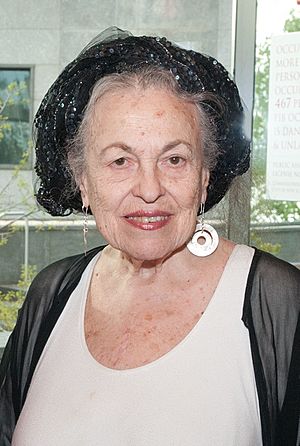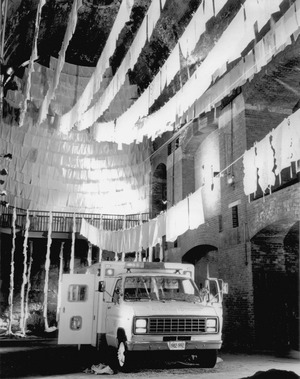Helène Aylon facts for kids
Quick facts for kids
Helène Aylon
|
|
|---|---|

Aylon in 2014
|
|
| Born |
Helene Greenfield
February 4, 1931 |
| Died | April 6, 2020 (aged 89) |
| Nationality | American |
| Education | Brooklyn College |
| Known for | Painting, Installation art, Multimedia art |
Helène Aylon (born Helene Greenfield; February 4, 1931 – April 6, 2020) was an American artist. She created art using many different types of media, like paintings and installations. She was also known as an eco-feminist artist, meaning her art often focused on protecting the environment and supporting women's rights. Her work explored three main themes: art that changed over time (in the 1970s), art against nuclear weapons (in the 1980s), and The G-d Project (from the 1990s to early 2000s). This last project looked at the Hebrew Bible and old traditions from a woman's point of view. In 2012, Aylon wrote a book called Whatever Is Contained Must Be Released: My Jewish Orthodox Girlhood, My Life as a Feminist Artist. She passed away in 2020 due to complications from COVID-19.
Contents
Early Life and Education
Helène Aylon was born in Brooklyn, New York. She grew up in an Orthodox Jewish family and could speak Hebrew fluently. She went to Shulamith School for Girls and the Midrasha for high school. However, she originally wanted to attend The High School of Music and Art in Manhattan. In 1949, she married Mandel H. Fisch, who was studying to become a rabbi.
After they married, Aylon moved to Montreal where her husband worked as a rabbi. They had two children, Nathaniel and Renee. The family later moved back to Brooklyn. Aylon's husband became ill in 1956 and passed away five years later when Aylon was 30 years old.
Before her husband's death, Aylon began studying art at Brooklyn College. One of her teachers was the famous artist Ad Reinhardt. After college, she was asked to paint a large mural for a youth center in Brooklyn. When a newspaper took her picture for an article, she decided to use the name Helène Aylon. She chose "Aylon" because it was the Hebrew version of her first name. Later, she taught art at San Francisco State University and the California College of Arts and Crafts in Oakland.
One of Aylon's first important artworks was Rauch (Spirit, Wind, Breath) from 1965. It was a 16-foot-long mural made for a synagogue library at JFK International Airport. This mural aimed to show Judaism through the eyes of women.
Art That Changes Over Time
In the 1970s, Helène Aylon started exploring a type of art called "process art" in California. This means the art changes or develops over time, often by chance.
She created a series called Paintings That Change (1974–77). This series included works like Tar Pouring and Drifting Boundaries. These paintings were made with oil on paper. The oil would slowly move and change the look of the artwork over time, depending on how it flowed.
In 1978, she began another series called The Breakings. For these pieces, she poured linseed oil onto large flat panels. The oil would form a thick skin. Then, she would tilt the panels, allowing gravity to pull the oil into a sac underneath the surface. This sac would eventually break, changing the artwork completely. These works were shown in galleries and museums, including the MIT and the Oakland Museum.
Art for the Environment and Peace
By the 1980s, Aylon described herself as an "eco-feminist." This meant she used her art to support environmental protection and women's rights. She began creating art that spoke out against nuclear weapons and for the environment.
One of her most famous works was Earth Ambulance. This was a real U-Haul van that she turned into an "ambulance." It symbolized her effort to save the world from nuclear war. Aylon traveled across the United States in this ambulance. She collected dirt from nuclear bases, uranium mines, and nuclear reactors. She put this dirt into pillowcases.
On June 12, 1982, she used these pillowcases in a protest at the United Nations. In front of many people, the pillowcases were carried down the steps of Ralph Bunche Park on army stretchers.
In 1992, to celebrate the end of the Cold War, she displayed the seed-filled ambulance in New York City. Pillowcases from her earlier projects were hung around it. For another project called Bridge of Knots, Aylon made long chains of knotted pillowcases. People wrote their dreams and worries about nuclear war on these pillowcases. These chains were then draped around buildings like the Knoxville Museum of Art and the Berkeley Art Museum.
In 1985, Aylon traveled to Japan. This was to mark 40 years since the atomic bombings of Hiroshima and Nagasaki. She sent floating sacks filled with seeds, grain, and bamboo down rivers towards these two cities as a symbol of peace and renewal. In 1995, a video of her sending these sacks was shown on a giant screen in Times Square.
The G-d Project
After her husband passed away in 1961, Helène Aylon began to think about reforming Judaism. She wanted to challenge ideas in the Five Books of Moses that seemed to favor men over women. In the 1990s, Aylon started her biggest project, The G-d Project, which had nine parts and took twenty years to complete.
The Liberation of G-d
The first part was called The Liberation of G-d. It featured the five books of Moses in both English and Hebrew, placed on velvet stands. Each page was covered with clear parchment. Aylon recorded the sound of turning parchment pages and played it on a loop during the exhibition. She also took the 54 sections of the Torah and placed them on glass shelves. Using a pink highlighter, she marked phrases that she felt showed unfair attitudes towards women or words that seemed to describe God as vengeful or cruel. This work was first shown in March 1996 at the Armand Hammer Museum of Art. Aylon invited rabbis to visit and discuss her artwork.
The Women's Section
In 1997, she finished The Women's Section, the second part of The G-d Project. This work was dedicated to women whose husbands would not give them a Jewish religious divorce, called a Get. Without this document, these women could not remarry. The artwork included texts from the Torah that discussed rules about women's bodies.
My Notebooks
In 1998, Aylon created My Notebooks, the third part. It had 54 blank notebooks arranged in columns. The closed notebooks looked like black columns, and the open ones looked like white columns. A projection of Aylon's photos from a Jewish girls' school was shown across the notebooks. This work was dedicated to important women from Jewish history, like Mrs. Rashi and Mrs. Maimonides. It was meant to highlight the lack of women's voices and scholarship in religious education. It also pointed out that female teachers in Aylon's school could only teach what male rabbis had written.
Epilogue: Alone With My Mother
The fourth work, Epilogue: Alone With My Mother, was made in 1999. It featured a large alcove with a bench facing a stand with two open Bibles that could not close. In these Bibles, the blessings and curses from the last chapters of Deuteronomy were highlighted. A recording of a conversation between Aylon and her mother played during the installation, which was dedicated to Aylon's mother.
My Bridal Chamber: My Marriage Contract
Also in 1999, Aylon created My Bridal Chamber: My Marriage Contract, the fifth work. It showed a simple bed covered with a white bedspread made from handkerchiefs and a wedding canopy. Around the bed were four columns with projected photos of Aylon in her wedding dress. Behind the headboard, Aylon wrote quotes from Leviticus about rules related to women's bodies. This artwork was a comment on the restrictions women felt in marriage and religion.
My Bridal Chamber: My Marriage Bed/My Clean Days
From 2000 to 2001, Aylon created My Bridal Chamber: My Marriage Bed/My Clean Days, the sixth work. In this piece, she projected changing images onto a white bedsheet to represent rules about women's monthly cycles. A recording of voices counted the waiting times between these cycles and ritual baths.
The Partition Is in Place, But the Service Can't Begin
In 2002, Aylon completed The Partition Is in Place, But the Service Can't Begin, the seventh work. This artwork featured a wall made of tzitzit (special fringes worn by religious men) and large photos of the Western Wall. This piece commented on how men and women are separated in Orthodox synagogues and at the Western Wall. Aylon noted that even if there were many women but not enough men, a religious service could not begin, as it requires ten men.
Wrestlers
Aylon also created Wrestlers (1980, 2005), the eighth work. It showed large landscape photographs with Aylon herself as a tiny figure, searching for important women from the past. In 2005, she added more meaning to Wrestlers by focusing on Lot's Wife and giving her a name: Hashemshela, which Aylon said means "her name" in Hebrew. Aylon dedicated Wrestlers to the artist Ana Mendieta.
All Rise
The ninth and final work in The G-d Project was All Rise (2007). This artwork imagined a feminist court where women, who are usually not allowed to be judges in a Beit Din (a Jewish court of law), could now judge. The artwork included a wooden platform with three steps and three chairs with tzitzit hanging from them. There were also two pink pillowcase-flags and signs that read "In G-d We Trust." A bench for those asking for judgment faced the court. Aylon explained, "I ask the traditional court of three males to include women as judges." She saw her work as "rescuing" the Earth, God, and women from old, male-dominated ideas.
Death
Helène Aylon passed away on April 6, 2020, at the age of 89, due to complications from COVID-19.
Public Collections and Recognition
Helène Aylon's art can be found in the permanent collections of major museums, including the Whitney Museum, the Museum of Modern Art, the San Francisco Museum of Modern Art, and the Jewish Museum. She received grants and awards from organizations like the National Endowment for the Arts and the Pollock-Krasner Foundation.
Awards
- 2016: Women's Caucus for Art Lifetime Achievement Award
See also
 In Spanish: Helène Aylon para niños
In Spanish: Helène Aylon para niños


